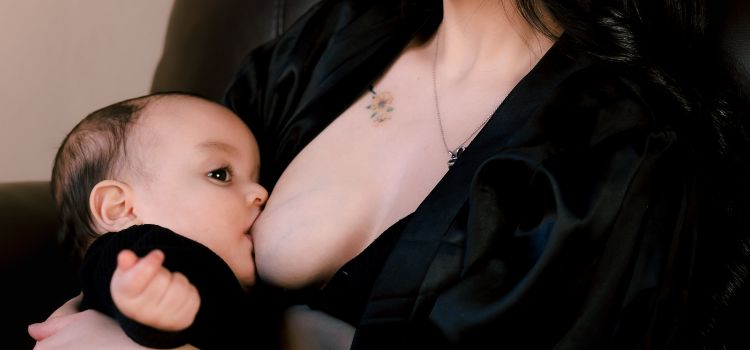Lipstick nipple breastfeeding is caused by improper latching leading to friction and trauma on the nipple, resulting in pain, redness, and sometimes bleeding during breastfeeding. Breastfeeding is a natural and bonding experience between a mother and her baby.

However, it is not always smooth sailing, and challenges can arise. One common problem that breastfeeding mothers may encounter is lipstick nipple breastfeeding. This condition occurs when the baby’s latch is not proper, causing friction and trauma on the nipple.
As a result, the mother may experience pain, redness, and sometimes bleeding during breastfeeding. Resolving this issue requires identifying and correcting the latching problems to ensure a comfortable and successful nursing experience for both mother and baby.
We will explore the causes, symptoms, and potential solutions for lipstick nipple breastfeeding.
The Definition Of Lipstick Nipple Breastfeeding
Lipstick nipple breastfeeding occurs when the baby’s mouth is opened wider than normal, causing the mother’s nipple to turn white and resemble the shape of a lipstick. This can be caused by a shallow latch or incorrect positioning.
Understanding The Concept And Implications Of Lipstick Nipple Breastfeeding
Lipstick nipple breastfeeding, also known as lipstick sign or lipstick formation, is a condition that affects breastfeeding mothers. It refers to the appearance of a flattened or compressed nipple after breastfeeding, resembling the shape of a lipstick.
Here’s what you need to know about the concept and implications of lipstick nipple breastfeeding:
Causes Of Lipstick Nipple Breastfeeding
- Shallow latch: When a baby doesn’t latch properly and only takes in a small amount of the nipple, it can lead to compression and deformation of the nipple.
- Poor positioning: Incorrect positioning of the baby during breastfeeding can cause excessive pressure on the nipple and result in lipstick nipple formation.
- Tongue-tie: If the baby has a restricted or tight lingual frenulum (the tissue that connects the tongue to the floor of the mouth), it can affect the proper latch and result in nipple compression.
Implications Of Lipstick Nipple Breastfeeding
- Discomfort: Mothers may experience discomfort and pain during breastfeeding due to the compressed nipple shape.
- Ineffective milk transfer: The flattened nipple may make it harder for the baby to effectively extract milk from the breast, leading to inadequate milk transfer.
- Reduced milk production: Lipstick nipple breastfeeding can negatively impact milk supply as inadequate milk removal may signal the body to produce less milk.
- Potential nipple damage: Continuous compression of the nipple can cause soreness, cracks, and even nipple trauma.
Overcoming Lipstick Nipple Breastfeeding
- Seek professional help: Consult a lactation consultant or healthcare provider knowledgeable in breastfeeding to assess latch and positioning techniques.
- Nipple care: Applying nipple creams or using nipple shields may help protect and soothe the nipple, allowing it to heal and regain its shape.
- Breast massage: Gentle breast massage before and after feedings can help improve milk flow and prevent nipple compression.
- Pumping: Using a breast pump can help stimulate milk production and maintain supply while allowing the nipple to recover and regain its original shape.
- Tongue-tie revision: If tongue-tie is causing persistent nipple compression, a healthcare provider may recommend a minor procedure called a frenotomy to release the restriction.
Remember, lipstick nipple breastfeeding is a common challenge that many breastfeeding mothers face. Seeking support and guidance can make a significant difference in overcoming this condition and ensuring a positive breastfeeding experience for both mother and baby.
Causes Of Lipstick Nipple Breastfeeding
Lipstick nipple while breastfeeding can be caused by shallow latch, incorrect positioning, tongue tie, or excessive pressure on the nipple.

Lipstick nipple breastfeeding, also known as nipple blanching, is a common issue that breastfeeding mothers may experience. It is characterized by the appearance of a pale or whitish color on the nipple after breastfeeding. While it may not be a serious concern, understanding its causes can help you address the issue effectively.
The causes of lipstick nipple breastfeeding can be attributed to the following factors:
Impact Of Improper Latch And Positioning
- Incorrect latch: Inadequate latch or incorrect positioning of the baby’s mouth on the breast can contribute to lipstick nipple breastfeeding. When the baby fails to latch on properly, it causes compression and constriction of blood vessels in the nipple, resulting in the lipstick appearance.
- Shallow latch: If the baby only latches onto the nipple without taking in enough areola, it can lead to increased pressure and reduced blood flow, causing the lipstick nipple effect.
The Role Of Nipple Shape And Size
- Flat or inverted nipples: If you have flat or inverted nipples, there is a higher chance of experiencing lipstick nipple breastfeeding. These types of nipples can make it more challenging for the baby to latch on effectively, increasing the likelihood of compression and blanching.
- Size of the nipple: Nipple size can also play a role in lipstick nipple breastfeeding. Nipples that are long or overly prominent might face more pressure during breastfeeding, which can result in blood vessel constriction and the lipstick appearance.
The Influence Of Breastfeeding Technique
- Forceful letdown: If you have a forceful milk ejection reflex, also known as a fast letdown, it can contribute to lipstick nipple breastfeeding. The excessive flow of milk can cause the baby to gulp quickly, leading to compression and blanching of the nipple.
- Infrequent breastfeeding: When your baby doesn’t breastfeed frequently enough, they may become overly hungry and exhibit aggressive sucking behavior. This can increase nipple pressure and result in lipstick nipple breastfeeding.
Understanding the causes of lipstick nipple breastfeeding can help you take appropriate measures to alleviate the issue. It is essential to ensure a proper latch and positioning, address any challenges related to nipple size, shape, or forceful letdown, and maintain a regular breastfeeding routine.
If you continue to experience difficulties or discomfort, consulting a lactation consultant or healthcare professional can provide valuable guidance and support.
Common Challenges Faced By Breastfeeding Mothers
Breastfeeding mothers often face challenges, and one common issue is lipstick nipple breastfeeding. This condition is caused by various factors and can make nursing uncomfortable for both mother and baby.
The Challenges Faced By Breastfeeding Mothers
Breastfeeding is a beautiful and natural way to nourish your baby, but it doesn’t come without its challenges. Many mothers experience difficulties during their breastfeeding journey, which can cause frustration and stress.
In this section, we will explore some common challenges faced by breastfeeding mothers and provide helpful tips on how to overcome them.
The Discomfort Of Cracked Or Sore Nipples
- Sore nipples are a common complaint among breastfeeding mothers. This can occur due to incorrect latching or positioning of the baby during breastfeeding.
- Cracked nipples can also be a result of the baby’s incorrect latch or a imbalance of milk supply.
- To alleviate discomfort, ensure that your baby is latching correctly by seeking assistance from a lactation consultant or a knowledgeable healthcare professional.
- Applying lanolin cream or nipple balm after each feeding session can also help soothe and heal sore or cracked nipples.
- Remember to always offer your baby the breast with the most comfortable nipple angle for both of you.
Dealing With Inadequate Milk Supply
- Some mothers may experience concerns about their milk supply, worrying that it may not be enough to meet their baby’s needs.
- Factors such as stress, fatigue, and medication can affect milk production. It’s important to remember that breastfeeding is a supply and demand process, and the more your baby feeds, the more milk your body will produce.
- Frequent and effective breastfeeding, along with the use of breast compressions, can help stimulate milk production.
- Taking care of your own health by eating a well-balanced diet, staying hydrated, and getting enough rest will also contribute to a healthy milk supply.
- If you continue to have concerns about your milk supply, consult with a lactation consultant who can provide personalized guidance and support.
Overcoming Nipple Confusion For The Baby
- Nipple confusion occurs when a baby has difficulty distinguishing between the mother’s nipple and artificial nipple substitutes, such as bottles or pacifiers.
- This can lead to difficulties with breastfeeding and latch issues.
- It is recommended to delay introducing artificial nipples until breastfeeding has been well-established, typically around 4-6 weeks.
- If your baby is experiencing nipple confusion, you can try different breastfeeding positions or use techniques like paced bottle feeding to help them transition between breast and bottle.
- Patience and persistence are key when overcoming nipple confusion. With time and practice, your baby will learn to differentiate between the breast and artificial nipples.
Breastfeeding can be a rewarding experience, but it’s important to acknowledge and address the challenges that may arise. By understanding and actively working through issues like sore nipples, inadequate milk supply, and nipple confusion, you can enhance your breastfeeding journey and ensure the best possible nourishment for your little one.
Remember, seeking support from lactation consultants and other experienced mothers can provide valuable advice and reassurance along the way.
Addressing Lipstick Nipple Breastfeeding
Lipstick nipple breastfeeding can be caused by improper latch or positioning during nursing. This can lead to discomfort and pain for both the mother and baby. Understanding proper latch techniques and seeking support from lactation consultants can help address and alleviate this issue.

When it comes to breastfeeding, many mothers may experience challenges such as nipple pain, soreness, or even changes in the appearance of the nipple. One common issue that some mothers face is lipstick nipple breastfeeding, also known as blanching or vasospasm.
This condition is characterized by the nipple turning white or pale during or after breastfeeding, resembling the appearance of applying lipstick. While the exact cause of lipstick nipple breastfeeding is not fully understood, there are several effective strategies for addressing and managing this condition.
In this section, we will explore some useful tips and techniques, proper nipple care, and seeking guidance from lactation consultants.
Tips And Techniques For Improving Latch And Positioning
- Ensure a good latch: Proper latch is crucial for effective breastfeeding and can help alleviate nipple discomfort.
- Position your baby correctly: Make sure your baby’s mouth is wide open, with their tongue covering the lower gum.
- Aim for a deep latch: Encourage your baby to take a large portion of the areola into their mouth, not just the nipple.
- Seek professional guidance: Consider reaching out to a lactation consultant for personalized advice and assistance with latch and positioning.
Proper Nipple Care And Treatment
- Keep nipples moisturized: Dry nipples can contribute to nipple discomfort. Consider using a lanolin-based nipple cream or natural oils to keep the nipples moisturized between feedings.
- Use warm compresses: Applying a warm compress to the affected nipple before breastfeeding can help improve blood flow and alleviate vasospasm.
- Take breaks and relax: Stress and tension can worsen vasospasm. Take breaks during breastfeeding sessions and try relaxation techniques like deep breathing or gentle stretching.
Seeking Support And Guidance From Lactation Consultants
- Consult with a lactation consultant: If you are experiencing persistent lipstick nipple breastfeeding, seeking professional help can greatly benefit both you and your baby. Lactation consultants are trained to provide guidance on various breastfeeding issues, including vasospasm.
- Get personalized advice: A lactation consultant can assess your unique situation and provide tailored recommendations for managing lipstick nipple breastfeeding. They can also help address any other breastfeeding concerns you may have.
Long-Term Solutions For Lipstick Nipple Breastfeeding
Lipstick nipple breastfeeding is caused by inadequate latch and positioning during breastfeeding. Long-term solutions include working with a lactation consultant, addressing latch issues, and practicing proper breastfeeding techniques.

While it may be uncomfortable or painful, there are long-term solutions to help alleviate this problem. By implementing techniques for establishing a strong breastfeeding foundation, engaging in regular breast care to prevent complications, and seeking ongoing support and education, breastfeeding mothers can overcome lipstick nipple and continue to nurse their baby successfully.
Techniques For Establishing A Strong Breastfeeding Foundation
- Proper latch: Ensure that the baby is latching onto the breast correctly to minimize nipple distortion.
- Positioning: Experiment with different breastfeeding positions to find the one that is most comfortable for both mother and baby.
- Breast massage: Gently massaging the breast before and during breastfeeding can help relax the tissue and promote a more effective latch.
- Breast compression: Applying gentle pressure to the breast while the baby is nursing can help prevent nipple distortion.
Engaging In Regular Breast Care To Prevent Complications
- Proper hygiene: Maintain good breast hygiene by washing with a mild soap and warm water, and patting dry thoroughly.
- Moisturizing: Apply a lanolin-based cream or a natural plant-based oil to keep the nipple area moisturized and prevent dryness or cracking.
- Avoid tight-fitting bras: Opt for nursing bras that provide ample support without constricting the breasts, as tight bras can contribute to nipple discomfort.
- Monitor for infection: Keep an eye out for signs of infection, such as redness, swelling, or discharge, and seek medical attention if necessary.
The Importance Of Ongoing Support And Education
- Lactation consultant: Consult with a lactation professional who can provide guidance, support, and reassurance during your breastfeeding journey.
- Breastfeeding support groups: Join local or online support groups where you can connect with other breastfeeding mothers and share experiences and advice.
- Educational resources: Stay informed about breastfeeding techniques, nipple care, and potential challenges through books, websites, and reputable sources.
- Seek professional help: If you continue to experience lipstick nipple despite your best efforts, don’t hesitate to reach out to a healthcare provider specializing in lactation for further evaluation and assistance.
By following these techniques for establishing a strong breastfeeding foundation, engaging in regular breast care, and seeking ongoing support and education, you can overcome lipstick nipple breastfeeding and foster a positive and fulfilling breastfeeding experience for both you and your baby.
Remember, every breastfeeding journey is unique, and with perseverance and support, you can successfully navigate any challenges that may arise.
Seeking Professional Help For Lipstick Nipple Breastfeeding
Discover the causes of lipstick nipple breastfeeding and find professional help for this issue. Seek expert assistance in understanding and resolving the underlying factors contributing to this breastfeeding challenge.
Are you experiencing challenges with breastfeeding and noticing a lipstick-like appearance on your baby’s lips? This phenomenon, commonly referred to as lipstick nipple breastfeeding, can be a cause for concern among new mothers. While it may seem unsettling, seeking professional help can provide you with the guidance and support needed to address this issue.
Here are some reasons why consulting a healthcare professional or lactation specialist is beneficial in resolving lipstick nipple breastfeeding:
Various Resources For Lactation Support And Consultation Services
Seeking help from healthcare professionals can offer valuable resources and support to enhance your breastfeeding experience. Here are some options to consider:
- Lactation Consultants: These experts specialize in breastfeeding support and can provide personalized assistance tailored to your individual needs. They can evaluate your breastfeeding technique, suggest improvements, and help you establish a more comfortable latch.
- Pediatricians: Consulting your baby’s pediatrician can provide insights into the underlying causes of lipstick nipple breastfeeding. They can assess your baby’s overall health and rule out any medical conditions that may be contributing to the issue.
- La Leche League: This international nonprofit organization offers peer support and educational resources to breastfeeding families. They have experienced leaders who can provide guidance and share information on lipstick nipple breastfeeding.
- Online Communities: Participating in online forums and support groups allows you to connect with other breastfeeding mothers who may have experienced similar challenges. Sharing your concerns and experiences can provide a sense of comfort and community.
Understanding When It’S Necessary To Consult A Healthcare Professional
While some breastfeeding challenges can be resolved through self-help techniques, there are instances where professional guidance becomes necessary. Here are a few signs that indicate it’s time to seek expert help:
- Persistent Pain: If you’re experiencing ongoing pain or discomfort during breastfeeding, it’s crucial to consult a healthcare professional. They can assess the latch, positioning, and other factors that may be contributing to the pain.
- Insufficient Weight Gain: If your baby isn’t gaining weight adequately or seems consistently hungry after breastfeeding, seeking professional help is essential. A healthcare provider can evaluate your baby’s feeding patterns and ensure they’re receiving enough milk.
- Engorgement or Mastitis: If you’re experiencing severe breast engorgement or symptoms of mastitis, such as fever or flu-like symptoms, it’s important to consult a healthcare professional promptly. These conditions require medical attention to prevent complications.
The Benefits Of Seeking Expert Guidance In Resolving Breastfeeding Challenges
Obtaining professional help for lipstick nipple breastfeeding offers several advantages to both you and your baby. Here are some benefits of seeking expert guidance:
- Individualized Support: Healthcare professionals can provide personalized advice based on your specific needs and circumstances. They can assess your technique, suggest modifications, and offer tailored solutions to resolve breastfeeding challenges.
- Confidence and Peace of Mind: Expert guidance can boost your confidence in breastfeeding, alleviating any concerns or anxieties you may have. Having a professional validate your efforts and provide reassurance can bring peace of mind.
- Strengthened Bond: Resolving breastfeeding challenges can enhance the bond between you and your baby, leading to a more satisfying and fulfilling nursing experience. Professional guidance can help you establish a comfortable and enjoyable breastfeeding relationship.
- Continued Support: Healthcare professionals can offer ongoing support as you navigate your breastfeeding journey. They can address any new challenges or concerns that may arise, ensuring a successful and rewarding breastfeeding experience for both you and your baby.
Remember, seeking professional help for lipstick nipple breastfeeding is not a sign of weakness but a proactive step towards providing the best care for yourself and your baby. Reach out to the resources available to you and embrace the guidance they can provide.
Frequently Asked Questions
Why Do My Nipples Look Like Lipstick After Feeding?
Breasts respond to feeding by swelling and protruding, causing the nipples to appear like lipstick.
What Should A Nipple Look Like After Feeding?
After feeding, a nipple should look normal, without any major changes or discomfort.
What Do Damaged Nipples Look Like Breastfeeding?
Damaged nipples may appear cracked, bleeding, blistered, sore, or have scabs when breastfeeding.
How Can I Get My Baby To Have A Deeper Latch?
To get your baby to have a deeper latch, try these tips: Position yourself comfortably, bring baby’s nose to your nipple, support baby’s neck and head, and aim for a wide open mouth.
Conclusion
To sum it up, lipstick nipple breastfeeding is a common concern for new mothers. It occurs when the baby’s lips leave marks on the mother’s breasts that resemble the transfer of lipstick. This is caused by improper latch or positioning during breastfeeding.
The good news is that with the right knowledge and techniques, it can be easily avoided or resolved. Make sure to seek guidance from a lactation consultant or a healthcare provider who can provide you with proper guidance and support.
Remember to establish a deep latch, maintain a comfortable and correct position, and advocate for your own well-being as well. With patience, practice, and support, you can overcome this challenge and enjoy a successful and comfortable breastfeeding journey.
Don’t hesitate to reach out for help when needed, as there are many resources available to assist you.
Leave a Reply